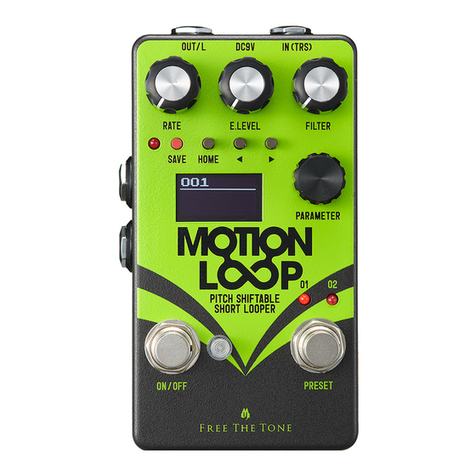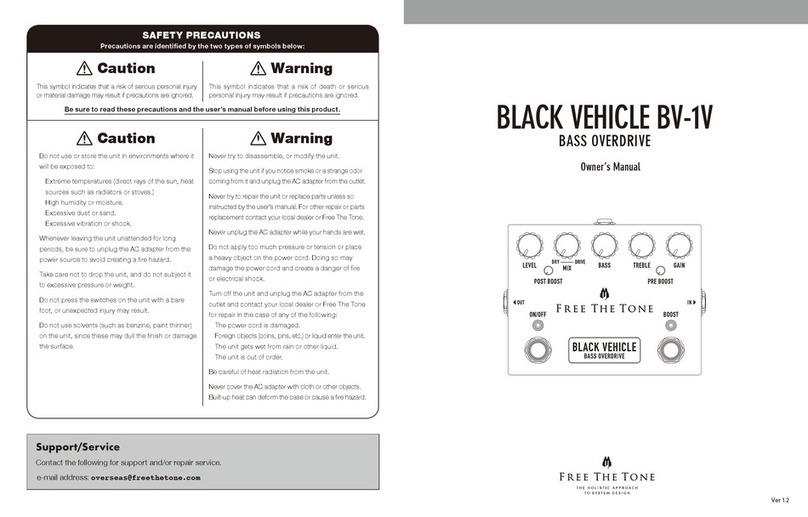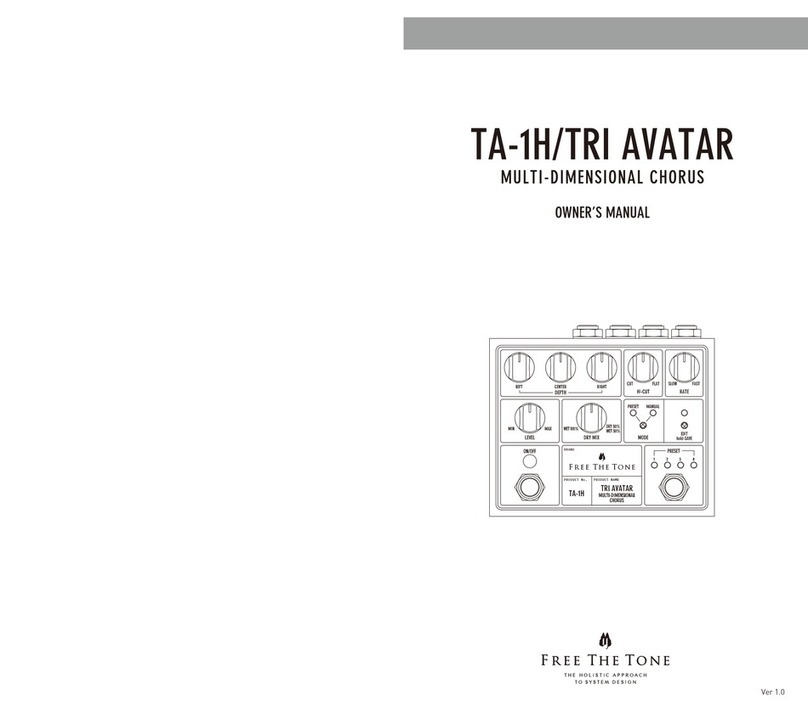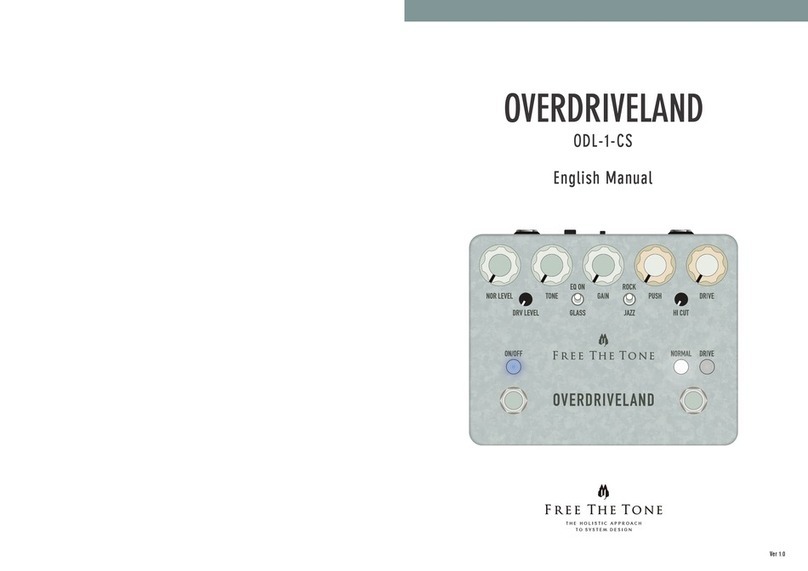67
Adjusting reverb (Manual mode) Changing/writing preset contents (Edit mode)
Configuring MIDI signal reception settings
Switching presets (Preset mode)
Adjusting reverb sound When the unit is put in Edit mode from Manual mode
When the unit is put in Edit mode from Preset mode
Changing MIDI reception settings
Switching between four presets
Confirming the position of each knob stored in the preset
NOTE
In Preset mode turning each knob does not change reverb sounds. Only the reverb sound in the preset is output.
NOTE
Turning the PRE DELAY knob while inputting signals interrupts the sound. This is not a malfunction.
NOTE
The PRESET 1 LED illuminates: The knob is moving in the counterclockwise direction comparing its current
position with the position stored in the preset.
The PRESET 4 LED illuminates: The knob is moving in the clockwise direction comparing its current position
with the position stored in the preset.
The PRESET 2 and PRESET 3 LEDs illuminate: The knob is at the same position as stored in the preset.
NOTE
By pressing the EDIT switch again after turning the knobs to change parameters in Edit mode, your changes
are canceled and the unit returns to the status in which the original preset is recalled.
NOTE
By pressing the EDIT switch again after turning the knobs to change parameters in Edit mode, your changes
are canceled and the unit returns to the status in which the original preset is recalled.
NOTE — Meaning of the ON/OFF LED statuses:
• ON/OFF LED illuminates: Omni mode is turned on. All of the MIDI channels will be accepted.
• ON/OFF LED is flashing: Omni mode is turned off. MIDI receiving channels can be set. Refer to “Setting
MIDI receiving channels (p.8)”.
• ON/OFF LED is turned off: MIDI receiving function is disabled.
Select one of the six reverb modes in the AMBI SPACE and adjust various parameters to create your desired
reverberation sound.
When the LED above the EDIT switch illuminates, the unit is in Edit mode. Edit mode is used to change/write
preset contents and pressing the EDIT switch puts the unit in this mode.
When the PRESET LED above the MODE switch illuminates, the unit is in Preset mode. In Preset mode, the reverb
sound stored in the preset selected by the PRESET select switch is recalled.
The AMBI SPACE can switch presets and change each parameter by MIDI signals received from an external
controller.
1. Press the MODE switch to illuminate the PRESET LED.
2. Press the PRESET select switch to select the preset.
1. Recall the desired preset.
2. Press the EDIT switch. The PRESET LED for the selected preset flashes.
3. Turn the desired knob clockwise or counterclockwise to confirm its stored position in the preset. The stored
knob position is indicated by the PRESET 1–4LEDs as shown in the note below.
1. Press the ON/OFF switch to illuminate the LED above it.
2. Turn the MODE encoder to select the desired reverb mode.
3. Turn the MIX knob to adjust the mixture level between the original and reverb sounds.
4. Turn the TONE knob to adjust the tone of the reverb sound.
5. Turn the DECAY knob to adjust the decay time of the reverb sound.
6. Turn the PRE DELAY knob to adjust the delay to start feeding the reverb sound.
The current Manual mode setting is written to the preset.
1. Press the EDIT switch to enter into Edit mode.
2. Press the PRESET select switch to select the preset number destination for storing the settings. You can
confirm your selection in advance because the LED flashes to show the destination preset number.
3. Press and hold the EDIT switch for 1.5 s. The LED above the switch flashes and the writing operation is
executed. After writing, the contents of that preset number is recalled and the unit enters Preset mode.
1. While holding down the PRESET select switch, turn on the power to the unit. Keep the switch pressed until
both the PRESET and MANUAL LEDs illuminate.
2. When both the LEDs illuminate, release the PRESET select switch.
3. Press the ON/OFF switch to toggle the MIDI reception settings.
4. Press the MODE switch to complete the setting.
You can adjust only the desired parameters of the current preset sound and store them in the preset.
1. Press the EDIT switch to enter into Edit mode.
2. Turn the knob of the parameter you want to change.
3. Press the PRESET select switch to select the preset number destination for storing the settings. If you want to
write your changes to the preset currently being edited, do not press the PRESET select switch and remain at
the current selection. You can confirm your selection in advance because the LED flashes to show the
destination preset number.
4. Press and hold the EDIT switch for 1.5 s. The LED above the switch flashes and the writing operation is
executed. After writing, the contents of that preset number is recalled and the unit enters Preset mode.
Reverb modes: Use the MODE encoder to select one of the reverb modes.
SPRING
PLATE Simulate a steel plate reverb. Metallic sounds with extended highs can be obtained.
ROOM Simulates reverberations in a room. Natural and warm reverberation sounds can be obtained.
HALL Simulates reverberations in a hall. Spatial and clear reverberation sounds can be obtained.
CAVE
SERENE
Simulates a spring reverb. Note that a real spring reverb does not have the PRE DELAY function but the AMBI SPACE is
deliberately designed to enable this function.
Reverb that can be used for sound effects or volume swell. Magnificent and pure reverberation sounds as if you are playing
in a cave can be obtained.
Frequency bands of reverberation sounds will also change according to the complex reverberation pattern design. You can
get pleasing reverberation sounds as if they were resonating from another space.






























